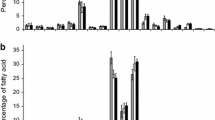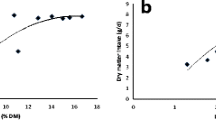Summary
The analyses performed on cropmilk freshly taken from the crop of both parents, lead to the following conclusions:
the dry weight of this cropmilk is very variable (between 3.6 and 32.2 %); on the contrary the dry weight of the milk taken from the crop of the squabs is nearly constant (26.0%);
the cropmilk doesn't contain any carbohydrates, except the ribose and desoxyribose from the nucleic acids;
the bulk of the proteins is formed by a “casein” with a low phosphor content (Table 1);
there seems to exist no difference between the composition of the cropmilk of the first and that of the last days of the lactation period, neither between that secreted by the male or that secreted by the female (Table 2);
the free amino acids as well as those contained in the hydrolysates were determined (Table 3);
the iodine number of the ether extracted lipids (70.65) is far superior to that of the lipids extracted by methanol-chloroform (23.80);
the composition of the milk, as it is given to the squabs, is: water 74.00%, ashes 1.37%, proteins 12.40%, other nitrogen compounds ±1.32%, lipids 8.61%.
Sommaire
Nous avons analysé le lait fraîchement prélevé du jabot des deux parents le matin à jeûn.
Le poids sec de ce lait est très variable (de 3,6 à 32,2%). Celui du lait prélevé dans le jabot des jeunes est au contraire presque constant: 26,0%.
Le lait de jabot ne contient d'autres hydrates de carbone que la ribose et la désoxyribose des acides nucléiques.
La plus grande partie des protéines est formée par une espèce de caséine à faible teneur en phoshore.
Il ne semble pas exister de différence entre la quantité de protéines contenue dans le lait des premiers et celui des derniers jours de la période de lactation, ni entre celui secreté par le mâle et celui secreté par la femelle.
Les acides aminés libres et ceux contenus dans les hydrolysats ont été déterminés qualitativement.
L'indice d'iode des lipides extraits à l'éther (70,65) est de beaucoup supérieur à celui des lipides extraits au méthanol-chloroforme (23,80).
La composition du lait total, tel qu'il est fourni aux jeunes, est la suivante: eau 74,00%, cendres 1,37%, protéines 12,40%, autres substances azotées ± 1,32%, lipides 8,61%.
Similar content being viewed by others
Bibliographie
Abrams, J. T.: Animal nutrition and veterinary dietetics, 4th ed. Edinburgh: W. Green & Son, Lim. 1961.
Almquist, H. J., and C. R. Grau: The amino-acid requirements of the chicks. J. Nutr. 28, 325–331 (1944).
—, E. Mecchi, E. L. Stokstadt, and P. D. Manning: Identification of the rice factor. The carbohydrate component. J. biol. Chem. 134, 465–466 (1940).
Arnold, A., O. L. Kline, C. A. Elvehjem, and E. R. Hart: Further studies on the growth factors required by chicks. The essential nature of arginine. J. biol. Chem. 116, 699–709 (1936).
Baldwin, E.: Dynamic aspects of biochemistry. Cambridge: Univ. Press 1957.
Bernard, Cl.: Leçons sur les propriétés physiologiques et les altérations pathologiques des liquides de l'organisme, tome 2, pp. 235–240. Paris: Baillière 1859.
Bialaszewickz, K., et M. Lewin: Sur la composition des cendres de la sécrétion du jabot des pigeons en ≪lactation≫. Acta Biol. exp. (Warszawa) 12, 265–270 (1938).
Block, R., E. Durrum, and G. Zweig: A manual of paper chromatography and paper electrophoresis, 2nd ed. New York: Academic Press Inc. 1958.
Boemer, A., A. Juckenack, u. J. Tillmans: Handbuch der Lebensmittelchemie. III. Tierische Lebensmittel. Berlin: Springer 1936.
Carr, R. H., and C. M. James: Synthesis of adequate proteins in the glands of the pigeon crop. Amer. J. Physiol. 97, 227–231 (1931).
Dabrowska, W.: The formation of pigeon milk, its chemical composition and its importance for the growth of squabs. Mem. Inst. Nat. Polonais écon. rurale Pulawy 13, 276–299 (1932a).
—: Sur la composition chimique de la sécrétion lactée du jabot du pigeon par rapport au taux d'acroissement des pigeonnaux. C. R. Soc. Biol. (Paris) 110, 1091–1093 (1932b).
Davies, W. L.: The composition of the crop milk of pigeons. Biochem. J. 33, 898–901 (1939).
Fisher, H., G. A. Leveille, and P. Griminger: The indispensable nature of arginine for maintenance in the rooster and its irreplaceability for chick growth by proline and glutamic acid. Poultry Sci. 38, 231–232 (1959).
Jeener, R.: Acides nucléiques et phosphatases au cours de phénomènes de croissance provoqués par l'oestradiol et la prolactine. Biochim. biophys. Acta (Amst.) 439–453 (1948).
McShan, N. H., J. S. Davis, S. W. Soukup, and R. K. Meyer: The nucleic acid content and succinic dehydrogenase actvity of stimulated pigeon crop gland tissue. Endocrinology 47, 274–280 (1950).
Noyons, E. G.: Chemie en Kliniek. Amsterdam: Van Holkema en Warendorf N. V. 1953.
Patterson, E. L., R. A. Milstrey, and T. H. Jukes: Arginine in the growth of chicks. Poultry Sci. 40, 459–467 (1961).
Reed, L. L., L. B. Mendel, and H. B. Vickery: The nutritive properties of the “crop-milk” of pigeons. Amer. J. Physiol. 102, 285–292 (1932).
Reid, E. W.: On “Pigeon's milk”. Rep. Brit. Ass. 812–814 (1894).
Rose, W. C.: The nutritional significance of amino-acids. Physiol. Rev. 18, 109–136 (1938).
Roy, D. N., and H. R. Bird: Stimulation of chick growth by prolins. Poultry Sci. 38, 192–196 (1959).
Urbach, C.: Stufenphotometrisehe Trinkwasseranalyse. Wien u. Leipzig: Emil Haim & Co. 1937.
Vandeputte-Poma, J., u. G. Van Grembergen: Freie Aminosäure in der Kropfmilch der Taube. Naturwissenschaften 76 (9), 329–330 (1959).
—: L'évolution postembryonnaire du poids du pigeon. Z. vergl. Physiol. 54, 423–425 (1967).
Author information
Authors and Affiliations
Rights and permissions
About this article
Cite this article
Vandeputte-Poma, J. Quelques données sur la composition du ≪Lait de Pigeon≫. Zeitschrift für vergleichende Physiologie 58, 356–363 (1968). https://doi.org/10.1007/BF00343509
Received:
Issue Date:
DOI: https://doi.org/10.1007/BF00343509




